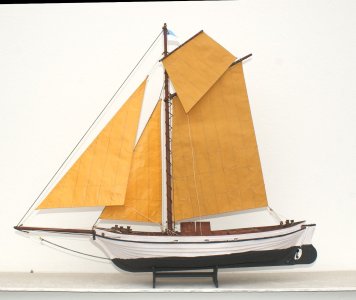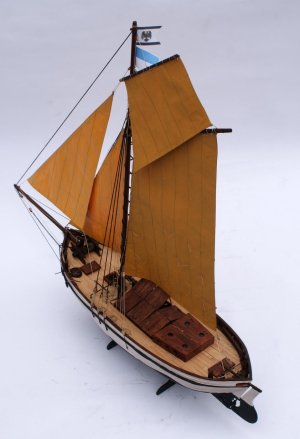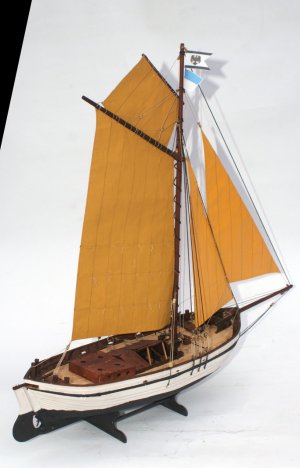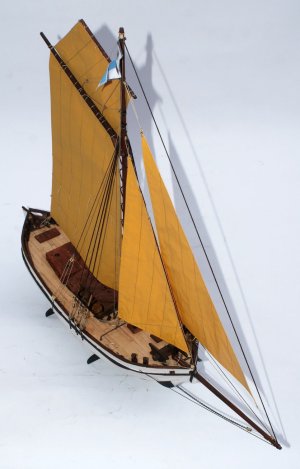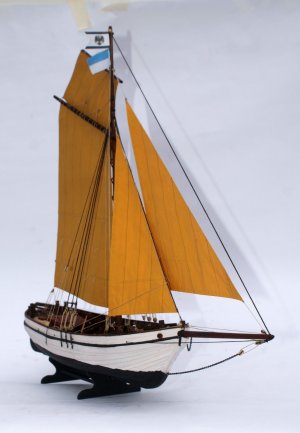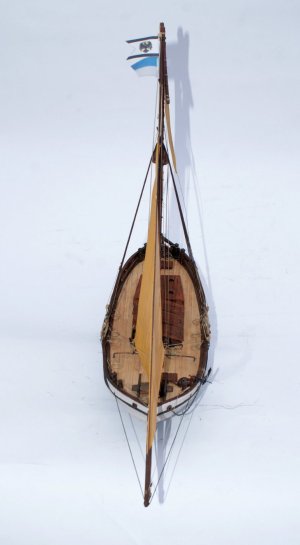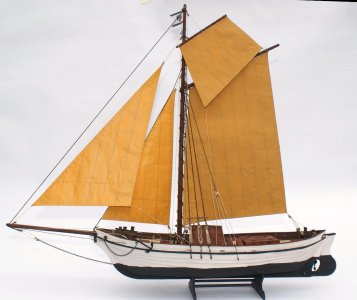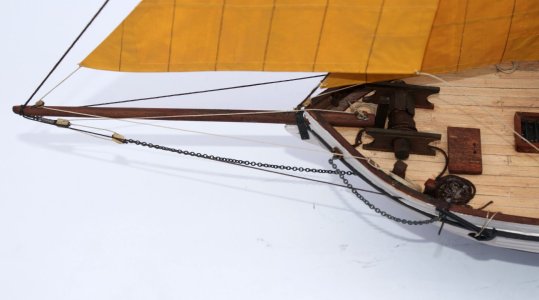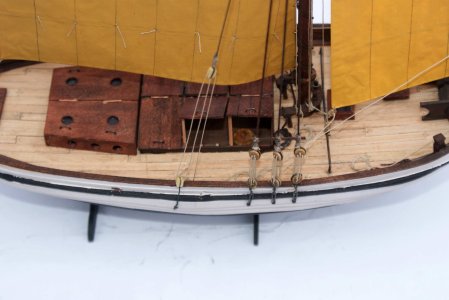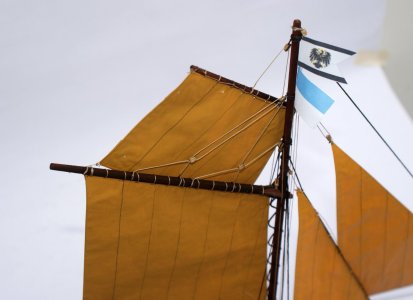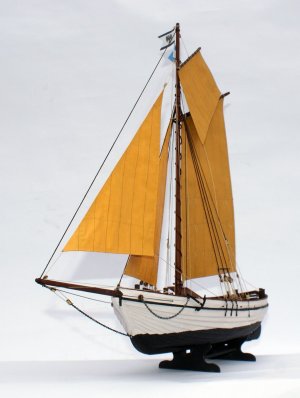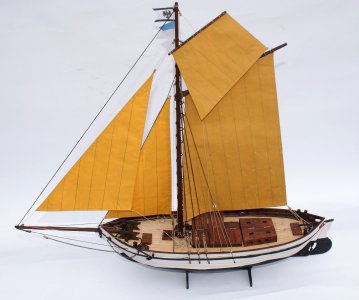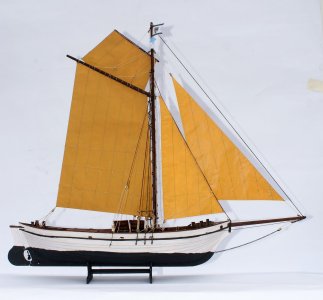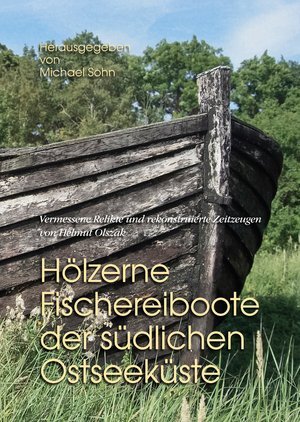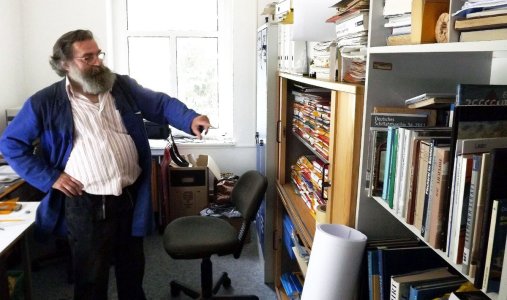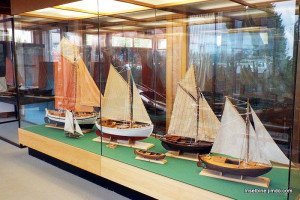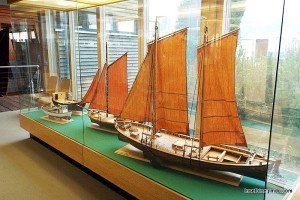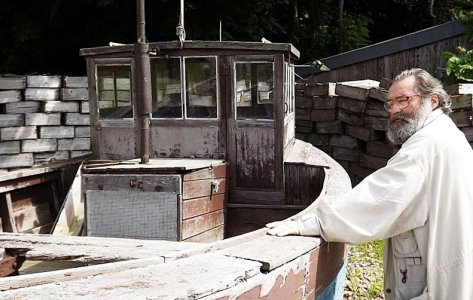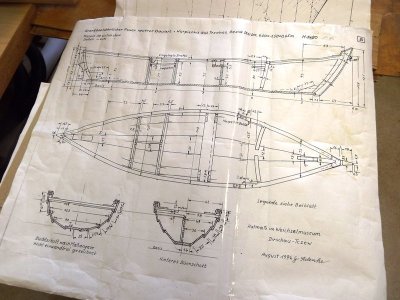Looking through the Modellbau Heute magazine from 1988, I was interested in a boat, widely used in the 19th and early 20th centuries in the Baltic Sea, and what caught my attention was the shed hull and its capacity to transport live fish to the port. This type of boat is called Quatze.
QUATZE HILDEGARD
1 History
The Quatze is usually confused with other boats such as the Polten. A generic description is given below; the paragraphs in quotation marks have been taken from the referenced documents that have been freely translated.
“On the German coast of the Baltic Sea, types of fishing boats were developed that can undoubtedly boast of being unique in their overall diversity and functionality. The decisive factors in the development of these ship types and designs were the different demands on fishing methods imposed by the diversity of species, the different water conditions, the seasonal changes in fish stocks and, finally, the regionally differentiated shipbuilding traditions.” “Influences from other Baltic Sea regions, such as Denmark and Sweden, but also the Netherlands, played an important role, as they were reflected in the boatbuilding technology, but without creating fundamentally new ship types. During this development, four main groups of ships emerged:
• Ships for inland or lagoon fishing.
• Beach fishing ships.
• Coastal fishing ships.
• Ships for deep-sea fishing.”
“This group includes the Quatze and also the Polten, when the latter were also used as commercial ships.”
Michael Sohn writes, “My interest was aroused by coming across this ship now called ERNESTINE on Rügen; this wooden, schooner-rigged sailing vessel was built on the old Quatze hull; unfortunately, for this hull there was not enough information about its original design and construction, which would have made a detailed plan possible. The present ERNESTINE also underwent changes during its reconstruction, which made it escape from its original Quatze condition; however, the size and proportions of the hull made a great impression on me. There is also a second Quatze hull in almost original condition at Zecherin near Wolgast. The OLL KORL has been stranded for years and has probably been without sails since at least the end of the World War. Only the main dimensions are known for this hull; there are no drawings. Finally, a usable piece of information was found in the German Historical Museum (Unter den Linden in Berlin), which comes from the archives of the former Oceanographic Museum in Berlin and is dated Stettin, June 1918. The original plan was drawn up by the engineer Karl Manthe, who designed the plans for HILDEGARD and shows the typical features of the turn of the century with a clipper-type stem and a high-beam keel, but without a centerboard like Rudolph's HELENE in 1911, and also a rather large fish hold, 4 m long. The shown plans for HILDEGARD show the two holds on the foredeck and the double separation between frames in the bunk area. The engine can be recognized as a large two-cylinder engine with a 1-meter diameter head and flywheel.”
“Only incomplete sources exist on the colors of the Quatze from the 1900s; The last Quatze seen in the first half of this century indicate that they had a light grey exterior, without any further differentiation or decorative stripes. Regarding the lagoon boats, Szymanski writes in "Deutsche Segelschiffe" that the topsides were painted white, black, light grey or green. The hull was covered with black tar. The deck and interior were usually only treated with pine tar, so that they had a dark brown to black colour.
“In June 1899, the "Ernestine" was launched as a Seequatze at the Karl Manthé shipyard in Wollin, Pomerania. Two years later it was first registered as a commercial fishing vessel in Stettin under the name "Hildegard" and sailed throughout the Baltic Sea without auxiliary machinery. In the early years, the owner was the fish wholesaler Martin Stöwahse in Stettin; the net loading capacity was 15 cubic meters.
Until the Second World War, it fulfilled its original function as a fish carrier: it collected live fish from fishing vessels and transported it to major port cities at home and abroad. At that time, when fish was not kept in freezers on ships and much of Pomerania was not yet connected to the railway, ships such as the Quatze were built with hulls provided with holes so that the catch could be transported along their sea routes and the hold was constantly bathed with fresh water….”
2 References
H. Olszak, „Quatzen und Polten: vergessene Bootstypen der pommerschen Küstenregion“, SSOAR Info. 2015
M. Sohn, „Pommersche Quatze" MBH 7'88
M. Sohn, „Quatze HILDEGARD" MBH 8'88
H. Szymanski, „Deutsche Segelschiffe“, Berlin 1934
 de.wikipedia.org
de.wikipedia.org
 ernestine-segeln.de
ernestine-segeln.de
 ernestine-segeln.de
https://www.schiffsspotter.de/Kutter/Quatze_Ernestine
ernestine-segeln.de
https://www.schiffsspotter.de/Kutter/Quatze_Ernestine
3 Model Construction
The main idea of this project is to make a model of the Quatze HILDEGARD as it was before its conversion, based on the MBH plans. Due to the lack of details, I have taken some liberties such as assuming the shape and type of handling of the hold covers or entrances to the cabin. Then, from these plans and the hull lines, the sections for the frames, the shape of the deck and the dimensions of the mast were obtained. It was drawn in AutoCAD and the false keel, frames and main parts were laser cut on a 3 mm plywood sheet. The dimensions of minor elements were taken to the scale of the same plans.
The pieces are disassembled, sanded and displayed. They are glued together with white glue, aligned and mounted on a frame. For the hull's hull, 1x6 mm cedar planks were used, mounted on a shed up to the deck level, where a 2x3 mm strip was glued, then 2 planks were placed butt-to-toe until the bow was complete. The planks were then carefully sanded, maintaining the protrusion of the plank. The openings were sealed with a mixture of putty, shavings and white glue; 225 and 380 grit sandpaper were used. The sanding was checked, and white base paint was used, sanding again and taking care to maintain the protrusion of the planks. Then, black acrylic paint was applied to the hull, and pearl white for the topside, the strip would be painted black.
For the deck, a 2mm thick piece was used and its shape was taken directly from the inside of the hull. 0.5 mm thick veneer was cut to simulate the deck planking. The slats would be 5x90 mm to be installed in a three-piece arrangement. The edges were blackened with charcoal and glued with white glue. It was then sanded with 250 grit sandpaper and left in its natural colour. The deck was taken and mounted on the frames, trying to avoid openings with the inside of the hull.
The rails and bollards were prepared, and the gunwale was mounted, all in walnut. The masts were made of cedar wood; the mainmast, gaff and bowsprit were given the corresponding taper using a brush, coarse and fine sandpaper; some holes were drilled and stained in dark walnut.
All the deck elements were fixed with white glue and the bowsprit and mainmast were aligned. Continuing with the model, the rudder, which has a usual shape and size, was prepared and painted. The two-bladed propeller painted black was also made from a sheet of brass and, as it is fragile, will be the last thing to be assembled. As complementary elements of the deck, an access ladder and a barrel will be placed inside the hold.
The sails were prepared from paper painted in two shades of golden ochre; a cotton thread was placed on the edges to give it strength and they were folded by gluing them with diluted white glue.
The assembly of the sails began, starting with the main sail. The ropes of different calibers, dark 0.8 mm for the shrouds and forestay, 0.5 mm for fixing; and in raw 0.4 mm for the halyards. Prepare the shrouds and the anchor. I decided not to place the ratlines, since from the photos of the current and old quatzes, they do not have them. Considering that the boat was modelled at the beginning of the 20th century, it has been considered to place the flags of the Kingdom of Prussia and that of Pomerania. In this last part we present the photos of the finished Quatze.
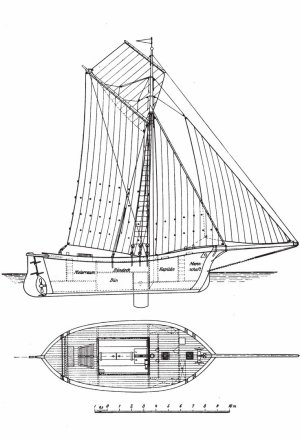
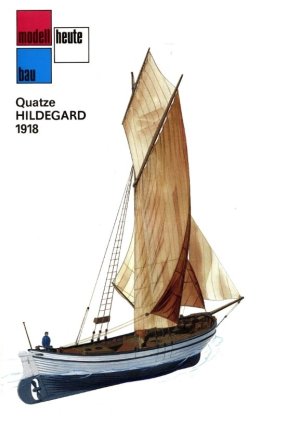
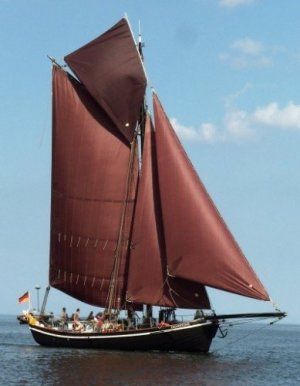

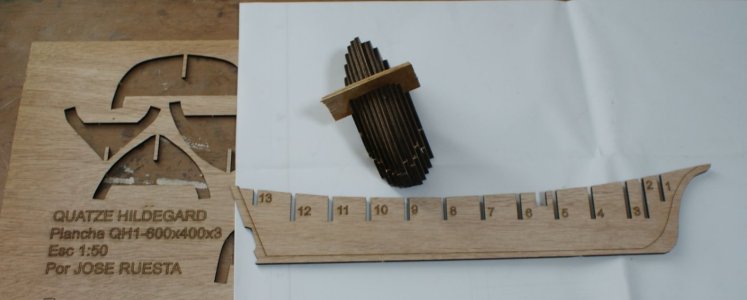
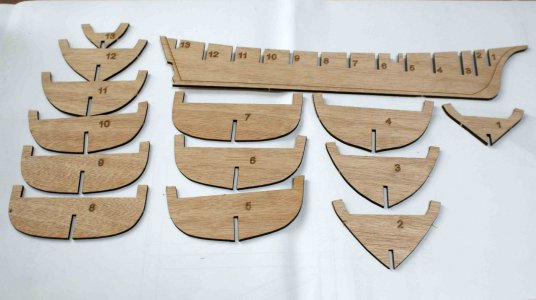
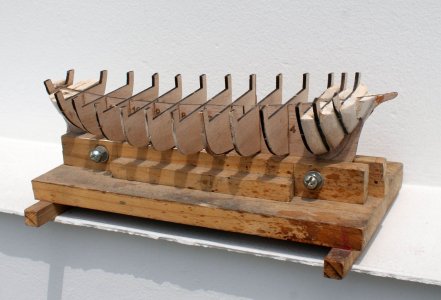
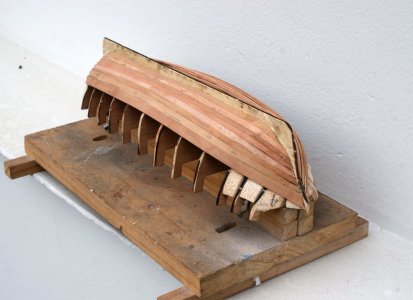

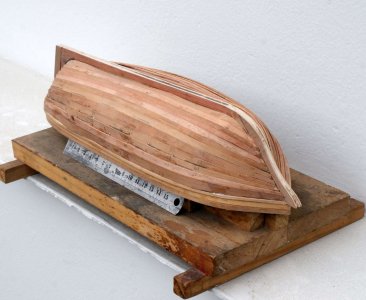
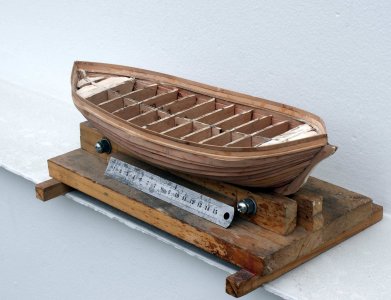
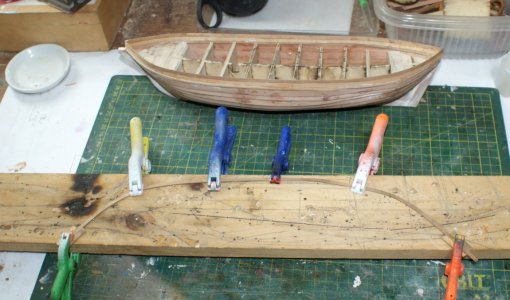
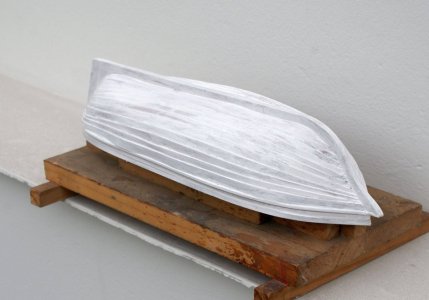


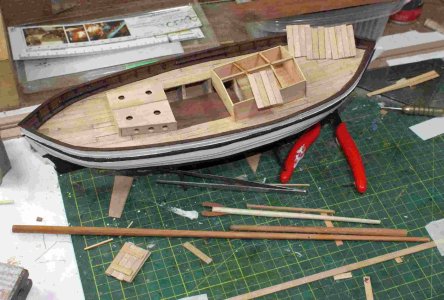
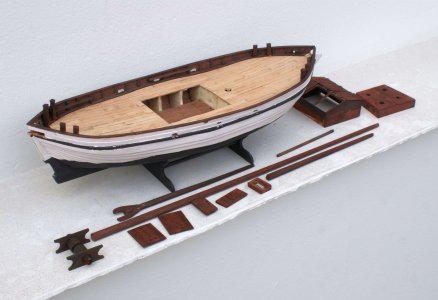
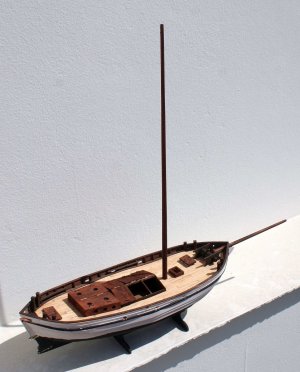
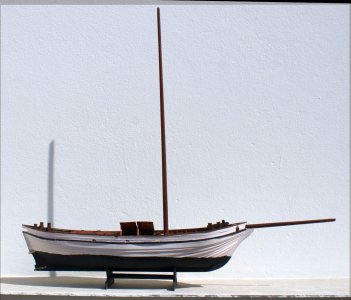
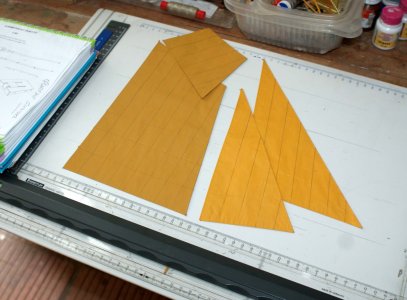
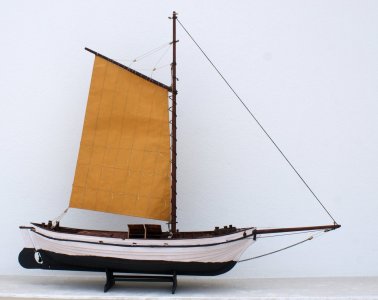
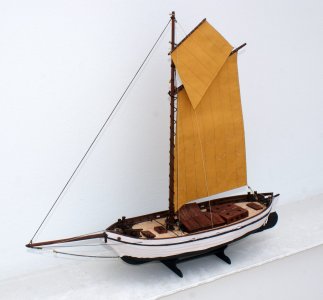
QUATZE HILDEGARD
1 History
The Quatze is usually confused with other boats such as the Polten. A generic description is given below; the paragraphs in quotation marks have been taken from the referenced documents that have been freely translated.
“On the German coast of the Baltic Sea, types of fishing boats were developed that can undoubtedly boast of being unique in their overall diversity and functionality. The decisive factors in the development of these ship types and designs were the different demands on fishing methods imposed by the diversity of species, the different water conditions, the seasonal changes in fish stocks and, finally, the regionally differentiated shipbuilding traditions.” “Influences from other Baltic Sea regions, such as Denmark and Sweden, but also the Netherlands, played an important role, as they were reflected in the boatbuilding technology, but without creating fundamentally new ship types. During this development, four main groups of ships emerged:
• Ships for inland or lagoon fishing.
• Beach fishing ships.
• Coastal fishing ships.
• Ships for deep-sea fishing.”
“This group includes the Quatze and also the Polten, when the latter were also used as commercial ships.”
Michael Sohn writes, “My interest was aroused by coming across this ship now called ERNESTINE on Rügen; this wooden, schooner-rigged sailing vessel was built on the old Quatze hull; unfortunately, for this hull there was not enough information about its original design and construction, which would have made a detailed plan possible. The present ERNESTINE also underwent changes during its reconstruction, which made it escape from its original Quatze condition; however, the size and proportions of the hull made a great impression on me. There is also a second Quatze hull in almost original condition at Zecherin near Wolgast. The OLL KORL has been stranded for years and has probably been without sails since at least the end of the World War. Only the main dimensions are known for this hull; there are no drawings. Finally, a usable piece of information was found in the German Historical Museum (Unter den Linden in Berlin), which comes from the archives of the former Oceanographic Museum in Berlin and is dated Stettin, June 1918. The original plan was drawn up by the engineer Karl Manthe, who designed the plans for HILDEGARD and shows the typical features of the turn of the century with a clipper-type stem and a high-beam keel, but without a centerboard like Rudolph's HELENE in 1911, and also a rather large fish hold, 4 m long. The shown plans for HILDEGARD show the two holds on the foredeck and the double separation between frames in the bunk area. The engine can be recognized as a large two-cylinder engine with a 1-meter diameter head and flywheel.”
“Only incomplete sources exist on the colors of the Quatze from the 1900s; The last Quatze seen in the first half of this century indicate that they had a light grey exterior, without any further differentiation or decorative stripes. Regarding the lagoon boats, Szymanski writes in "Deutsche Segelschiffe" that the topsides were painted white, black, light grey or green. The hull was covered with black tar. The deck and interior were usually only treated with pine tar, so that they had a dark brown to black colour.
“In June 1899, the "Ernestine" was launched as a Seequatze at the Karl Manthé shipyard in Wollin, Pomerania. Two years later it was first registered as a commercial fishing vessel in Stettin under the name "Hildegard" and sailed throughout the Baltic Sea without auxiliary machinery. In the early years, the owner was the fish wholesaler Martin Stöwahse in Stettin; the net loading capacity was 15 cubic meters.
Until the Second World War, it fulfilled its original function as a fish carrier: it collected live fish from fishing vessels and transported it to major port cities at home and abroad. At that time, when fish was not kept in freezers on ships and much of Pomerania was not yet connected to the railway, ships such as the Quatze were built with hulls provided with holes so that the catch could be transported along their sea routes and the hold was constantly bathed with fresh water….”
2 References
H. Olszak, „Quatzen und Polten: vergessene Bootstypen der pommerschen Küstenregion“, SSOAR Info. 2015
M. Sohn, „Pommersche Quatze" MBH 7'88
M. Sohn, „Quatze HILDEGARD" MBH 8'88
H. Szymanski, „Deutsche Segelschiffe“, Berlin 1934
Quatze – Wikipedia
Home • Traditionssegler Ernestine
Schiffsdaten • Traditionssegler Ernestine
3 Model Construction
The main idea of this project is to make a model of the Quatze HILDEGARD as it was before its conversion, based on the MBH plans. Due to the lack of details, I have taken some liberties such as assuming the shape and type of handling of the hold covers or entrances to the cabin. Then, from these plans and the hull lines, the sections for the frames, the shape of the deck and the dimensions of the mast were obtained. It was drawn in AutoCAD and the false keel, frames and main parts were laser cut on a 3 mm plywood sheet. The dimensions of minor elements were taken to the scale of the same plans.
The pieces are disassembled, sanded and displayed. They are glued together with white glue, aligned and mounted on a frame. For the hull's hull, 1x6 mm cedar planks were used, mounted on a shed up to the deck level, where a 2x3 mm strip was glued, then 2 planks were placed butt-to-toe until the bow was complete. The planks were then carefully sanded, maintaining the protrusion of the plank. The openings were sealed with a mixture of putty, shavings and white glue; 225 and 380 grit sandpaper were used. The sanding was checked, and white base paint was used, sanding again and taking care to maintain the protrusion of the planks. Then, black acrylic paint was applied to the hull, and pearl white for the topside, the strip would be painted black.
For the deck, a 2mm thick piece was used and its shape was taken directly from the inside of the hull. 0.5 mm thick veneer was cut to simulate the deck planking. The slats would be 5x90 mm to be installed in a three-piece arrangement. The edges were blackened with charcoal and glued with white glue. It was then sanded with 250 grit sandpaper and left in its natural colour. The deck was taken and mounted on the frames, trying to avoid openings with the inside of the hull.
The rails and bollards were prepared, and the gunwale was mounted, all in walnut. The masts were made of cedar wood; the mainmast, gaff and bowsprit were given the corresponding taper using a brush, coarse and fine sandpaper; some holes were drilled and stained in dark walnut.
All the deck elements were fixed with white glue and the bowsprit and mainmast were aligned. Continuing with the model, the rudder, which has a usual shape and size, was prepared and painted. The two-bladed propeller painted black was also made from a sheet of brass and, as it is fragile, will be the last thing to be assembled. As complementary elements of the deck, an access ladder and a barrel will be placed inside the hold.
The sails were prepared from paper painted in two shades of golden ochre; a cotton thread was placed on the edges to give it strength and they were folded by gluing them with diluted white glue.
The assembly of the sails began, starting with the main sail. The ropes of different calibers, dark 0.8 mm for the shrouds and forestay, 0.5 mm for fixing; and in raw 0.4 mm for the halyards. Prepare the shrouds and the anchor. I decided not to place the ratlines, since from the photos of the current and old quatzes, they do not have them. Considering that the boat was modelled at the beginning of the 20th century, it has been considered to place the flags of the Kingdom of Prussia and that of Pomerania. In this last part we present the photos of the finished Quatze.

























